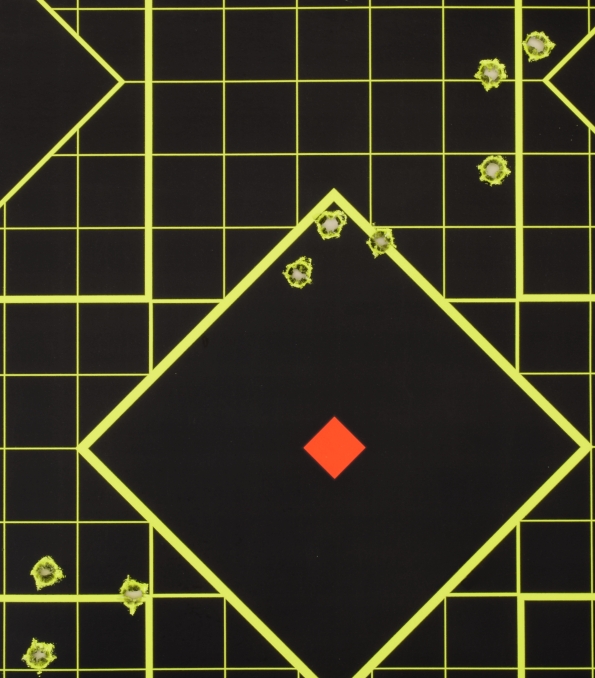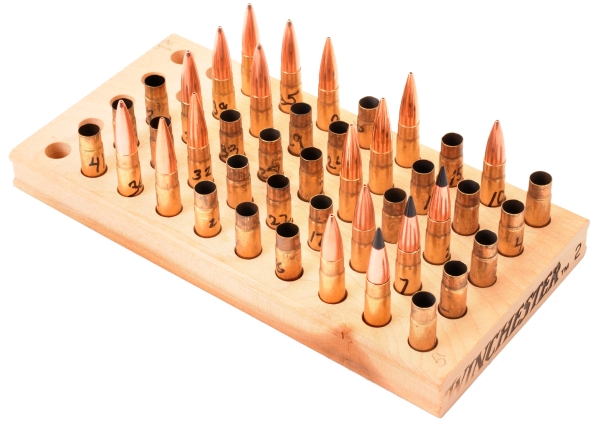The 300 Blackout is not a powerful cartridge. In fact, I am pretty sure I have a number of traditional handguns and a near 60 year old lever action 30-30 WCF with more thump. However, the 300 Blackout can make M4 types or Mini 14s solid deer hunting rifles without a lot of fuss or fanfare. Additionally, for video game playing engineers who need a suppressor in anticipation of a fire fight with Goofy and the X Men, the 300 Blackout is more of a natural than the 7.62×39.

The handloads developed for a recent Advanced Armament MPW project were evaluated for use with the Mini 14. Subsequently, the Hornady 130 grain bullet was dropped from the list and a 110 grain Barnes TAC-TX bullet and a 225 grain Hornady BTHP Match were added and the Mini 14, handloads, a chronograph, and targets were hauled to the range to see how the combination performed. The last may seem an unnecessary detail, however, it is the only way to really quantify performance. I have tried showing ad copy to wildlife with the hope they would surrender, however, the approach has proven to be less than reliable. Deer tend to run away and bear remain… aloof.
 |
Warning: Bullet selections are specific, and loads are not valid with substitutions of different bullets of the same weight. Variations in bullet material and length will alter net case capacity, pressure and velocity results. Primer selection is specific and primer types are not interchangeable. These data represents maximum loads in our firearms and test equipment and may easily be excessive in other applications. All loads should be reduced by 5%, and developed following safe handloading practices as represented in established reloading manuals produced by component manufacturers. Presentation of these loads does not constitute a solicitation for their use, nor a recommendation.
|
|||||||||||||||||||||||||||||||||||||||||||||||||||||||||||||||||||||||||||||||||||||||||||||||||||||||||||||||||||||||||||||||||||||||||||||||||||||||||||||||||||||
|
||||||||||||||||||||||||||||||||||||||||||||||||||||||||||||||||||||||||||||||||||||||||||||||||||||||||||||||||||||||||||||||||||||||||||||||||||||||||||||||||||||||
A couple of things… Jamison casings were not useful for reloading. Factory ammo yielded once fired brass with oversize primer pockets. Remington Open Tip Match subsonic ammo used in the unsuppressed firearm short stroked as the Ruger product information predicted it would. There were zero problems with supersonic ammo; feed or cycle, however, all loads with bullet weights below 168 grains got a deep crease across the shoulder. We’ll chalk that up to stiff handloads and, subsequently, overly exuberant ejection.

Accuracy for the Mini 14 300 Blackout was much easier to find than with the Mini Thirty 7.62x39mm and more consistent across various bullet weights. Point impact shifted significantly from one weight range to the other. Folks who would have others believe anything larger than sub MOA is a broken firearm… military expectation for 5 shot hundred yard groups for the M1 Garand was 5″, the M14 slightly larger, and the M16 slightly less. The M4 10 shot group spec is 5″. For the deer hunter, a critical target is dinner plate size.

| Indices | 168 Grain Berger VLD | ||||||||||
| Yards | 0 | 50 | 100 | 150 | 200 | 250 | 300 | 350 | 400 | 450 | 500 |
| Velocity – fps | 1979 | 1906 | 1835 | 1765 | 1697 | 1631 | 1568 | 1508 | 1450 | 1395 | 1342 |
| Energy – ft.-lbs. | 1461 | 1355 | 1256 | 1162 | 1074 | 993 | 917 | 848 | 784 | 725 | 671 |
| Momentum – lbs-sec | 1.47 | 1.42 | 1.36 | 1.31 | 1.26 | 1.21 | 1.17 | 1.12 | 1.08 | 1.04 | 1.00 |
| Path – in. | -1.5 | 1.9 | 3.0 | 1.5 | -2.9 | -10.2 | -20.8 | -35.0 | -52.9 | -75.0 | -101.6 |
| Best Zero Results | |||
| Near-Zero – yds. | 18 | Midrange – yds. | 96 |
| Far-Zero – yds. | 171 | Max Ordinate – in. | +3.0 |
| Point-Blank – yds. | 201 | ||
My favorite handload for the Mini 14 during the project was the 168 grain Berger, delivering the best accuracy. The design effective range for a 16″ barrel 300 Blackout is 460 meters, or 503 yards, but of greater interest to me is the Berger handload’s 200 yard point blank range and associated kinetic energy and momentum. 350 range is in the cards, but beyond that it is low orbit trajectory.
Day after day I’m more confused. Then I look for the light through the pourin’ rain
The 30-30 WCF outperforms the 300 Blackout; velocity, kinetic energy and trajectory, but then there are many cartridges that outperform the 30-30 WCF. So where is the line drawn? The combination of Mini 14 and 300 Blackout can serve many applications. Its light weight and power make it a valid deer and hog rifle in hilly woodland that is prevalent in the eastern and central U.S.. The absence of recoil and low report make it a nifty combination for young shooters. The Mini 14’s rate of fire and capacity make it a good combination for security. Its reliable function, durable finish and synthetic stock make it a good choice where low maintenance is desirable.

Ruger’s Mini 14 in Basic 300 Blackout Part I
Ruger’s Mini 14 in Basic 300 Blackout Part 2

Email Notification